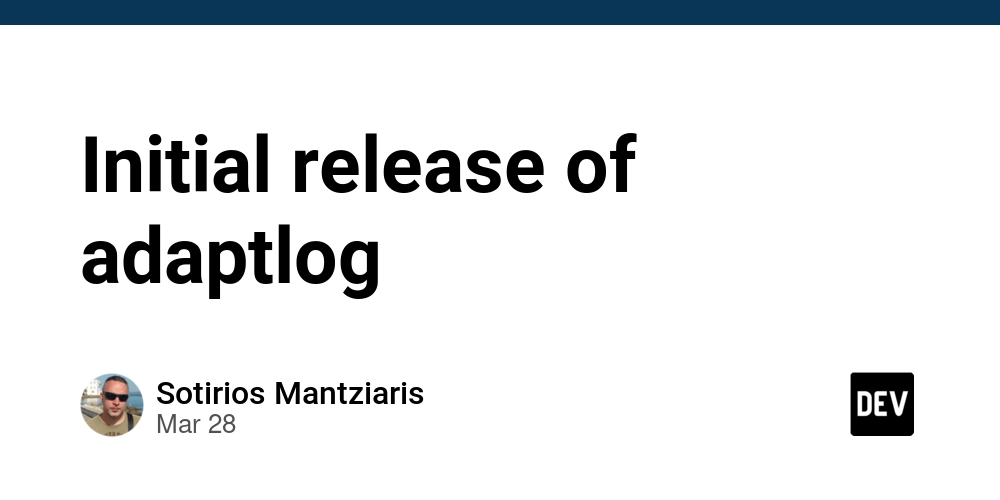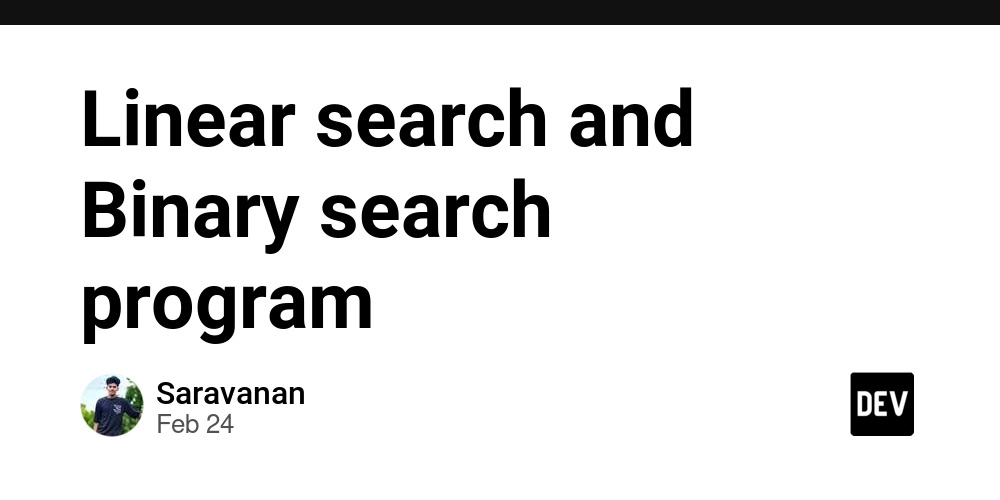Unlocking Opportunities: How to Become a Sponsored Developer
Abstract: In today's fast-paced tech world, building a career as a sponsored developer can transform your professional journey. This post explores the path to sponsorship with actionable strategies and practical advice, derived from the original article "Unlocking Opportunities: How to Become a Sponsored Developer" along with additional insights on personal branding, open-source funding, and networking. We’ll cover background context, core concepts, real-world applications, challenges, and future innovations—all designed to guide developers in securing financial support and industry recognition. Introduction In a landscape where technology is constantly evolving, developers are searching for ways to not only sharpen their technical skills but also gain recognition and financial backing. Becoming a sponsored developer can be a real game changer. With sponsorship, you gain access to resources, mentorship, and exposure while working on passion projects that push innovation forward. In this post, we present a comprehensive roadmap for developers who wish to embark on this journey and unlock new opportunities in the tech industry. Background and Context The idea of sponsorship in developer communities is not new. Traditionally, open-source projects depended on community contributions and voluntary work. However, as the demand for innovative software solutions increases, companies and organizations have begun to see the mutual benefits of sponsoring developers. This evolution has given rise to platforms like GitHub Sponsors which facilitate financial backing and broader outreach for talented developers. Key Definitions Sponsored Developer: An individual who secures financial support from companies or organizations in exchange for contributing to projects, often through open-source channels. Personal Branding: Building a professional identity via online presence, social media engagement, and technical blogs using platforms like Medium and Dev.to. Open Source Sponsorship: Financial and community support aimed at promoting sustainability and continuous innovation in open-source projects. Core Concepts and Features Becoming a sponsored developer involves several critical strategies: 1. Build a Strong Portfolio A compelling portfolio is your gateway to sponsorship. Here are the key elements: Comprehensive Project Documentation: Display your work on repositories hosted on GitHub. Testimonials: Include feedback from peers and industry experts. Visibility Through Contributions: Contributing to high-profile projects increases your chances of being noticed. 2. Develop a Personal Brand Your personal brand differentiates you in a crowded market. Consider these approaches: Active Social Media Engagement: Utilize Twitter and LinkedIn to share your insights and project updates. Content Creation: Write technical blogs on Medium or Dev.to and share your journey, coding tips, and project milestones. Innovative Marketing Strategies: Explore emerging trends like NFT Marketing to boost your online presence. 3. Network and Build Relationships Networking is key in the tech community. Strategies include: Attend Conferences and Meetups: Use platforms such as Meetup for local events. Engage in Online Tech Communities: Forums like Stack Overflow are excellent for sharing and learning. Join Open Source Sponsorship Initiatives: Discover opportunities through Open Source Sponsorship. 4. Identify and Engage Potential Sponsors Research companies that align with your expertise and values. Useful resources include: AngelList: Find forward-thinking tech companies on AngelList. Targeted Approaches: Study how mutual benefits and tailored proposals can secure sponsor interest by referring to the Benefits of GitHub Sponsors for Developers. 5. Craft a Compelling Proposal Your proposal should outline your achievements and the value you bring. Key points include: Detailing Accomplishments: Clearly articulate your project milestones. Articulating Mutual Benefits: Explain how sponsorship can drive innovation for both you and your sponsor. Tailored Communication: Customize each proposal to align with the sponsor’s mission and goals. 6. Reach Out and Follow Up Effective communication and persistence are essential: Personalize Outreach: Avoid generic messages—tailor your communication to each sponsor. Follow-Up Strategy: Use polite reminders and periodic updates to maintain engagement. 7. Negotiate Terms and Conditions Discuss fundamental aspects including: Financial Support: Agree on funding amounts and payment schedules. Project Deliverables: Define expectations and timeline. Intellectual Property: Clarify ownership and licensing issues. Table 1: Key Components of Developer Sponsorship Component Description Benefits Portfolio Collection of projects, documentation, and te

Abstract:
In today's fast-paced tech world, building a career as a sponsored developer can transform your professional journey. This post explores the path to sponsorship with actionable strategies and practical advice, derived from the original article "Unlocking Opportunities: How to Become a Sponsored Developer" along with additional insights on personal branding, open-source funding, and networking. We’ll cover background context, core concepts, real-world applications, challenges, and future innovations—all designed to guide developers in securing financial support and industry recognition.
Introduction
In a landscape where technology is constantly evolving, developers are searching for ways to not only sharpen their technical skills but also gain recognition and financial backing. Becoming a sponsored developer can be a real game changer. With sponsorship, you gain access to resources, mentorship, and exposure while working on passion projects that push innovation forward. In this post, we present a comprehensive roadmap for developers who wish to embark on this journey and unlock new opportunities in the tech industry.
Background and Context
The idea of sponsorship in developer communities is not new. Traditionally, open-source projects depended on community contributions and voluntary work. However, as the demand for innovative software solutions increases, companies and organizations have begun to see the mutual benefits of sponsoring developers. This evolution has given rise to platforms like GitHub Sponsors which facilitate financial backing and broader outreach for talented developers.
Key Definitions
- Sponsored Developer: An individual who secures financial support from companies or organizations in exchange for contributing to projects, often through open-source channels.
- Personal Branding: Building a professional identity via online presence, social media engagement, and technical blogs using platforms like Medium and Dev.to.
- Open Source Sponsorship: Financial and community support aimed at promoting sustainability and continuous innovation in open-source projects.
Core Concepts and Features
Becoming a sponsored developer involves several critical strategies:
1. Build a Strong Portfolio
A compelling portfolio is your gateway to sponsorship. Here are the key elements:
- Comprehensive Project Documentation: Display your work on repositories hosted on GitHub.
- Testimonials: Include feedback from peers and industry experts.
- Visibility Through Contributions: Contributing to high-profile projects increases your chances of being noticed.
2. Develop a Personal Brand
Your personal brand differentiates you in a crowded market. Consider these approaches:
- Active Social Media Engagement: Utilize Twitter and LinkedIn to share your insights and project updates.
- Content Creation: Write technical blogs on Medium or Dev.to and share your journey, coding tips, and project milestones.
- Innovative Marketing Strategies: Explore emerging trends like NFT Marketing to boost your online presence.
3. Network and Build Relationships
Networking is key in the tech community. Strategies include:
- Attend Conferences and Meetups: Use platforms such as Meetup for local events.
- Engage in Online Tech Communities: Forums like Stack Overflow are excellent for sharing and learning.
- Join Open Source Sponsorship Initiatives: Discover opportunities through Open Source Sponsorship.
4. Identify and Engage Potential Sponsors
Research companies that align with your expertise and values. Useful resources include:
- AngelList: Find forward-thinking tech companies on AngelList.
- Targeted Approaches: Study how mutual benefits and tailored proposals can secure sponsor interest by referring to the Benefits of GitHub Sponsors for Developers.
5. Craft a Compelling Proposal
Your proposal should outline your achievements and the value you bring. Key points include:
- Detailing Accomplishments: Clearly articulate your project milestones.
- Articulating Mutual Benefits: Explain how sponsorship can drive innovation for both you and your sponsor.
- Tailored Communication: Customize each proposal to align with the sponsor’s mission and goals.
6. Reach Out and Follow Up
Effective communication and persistence are essential:
- Personalize Outreach: Avoid generic messages—tailor your communication to each sponsor.
- Follow-Up Strategy: Use polite reminders and periodic updates to maintain engagement.
7. Negotiate Terms and Conditions
Discuss fundamental aspects including:
- Financial Support: Agree on funding amounts and payment schedules.
- Project Deliverables: Define expectations and timeline.
- Intellectual Property: Clarify ownership and licensing issues.
Table 1: Key Components of Developer Sponsorship
| Component | Description | Benefits |
|---|---|---|
| Portfolio | Collection of projects, documentation, and testimonials | Establishes credibility and technical expertise |
| Personal Brand | Online presence through blogs and social media | Enhances visibility and attracts sponsor interest |
| Networking | Engagement through meetups, forums, and open source communities | Builds trust and opportunities for collaboration |
| Proposal Crafting | Detailed documentation of achievements and sponsorship benefits | Communicates value effectively |
| Negotiation | Discussion of terms including financial and intellectual property rights | Establishes clear, fair agreements |
Applications and Use Cases
Sponsorship is not only ideal for personal growth but also for specific projects. Here are a few practical examples:
Example 1: Open Source Security Tool
A developer creates an innovative security tool used by companies worldwide. By leveraging platforms like GitHub, the developer showcases detailed case studies and customer testimonials. With a strong personal brand on LinkedIn and Twitter, the project attracts sponsorship from cybersecurity firms looking to invest in cutting-edge solutions.
Example 2: Blockchain Integration Projects
Developers are also harnessing the power of blockchain technology by working on projects that integrate with ecosystems like Arbitrum for enhanced scalability and security. By engaging in community events (using Meetup) and technical discussions on Stack Overflow, these developers secure sponsorships from companies interested in blockchain adoption.
Example 3: NFT-Based Applications and Marketing
Innovative developers explore NFT-based applications to create unique user experiences. By merging traditional coding expertise with NFT marketing strategies, they gain the attention of sponsors who seek to tap into emerging markets. References like NFT Marketing and successful case studies on GitHub Sponsors serve as excellent examples for entrepreneurs in this space.
Challenges and Limitations
While the road to sponsorship is paved with opportunities, several challenges may arise:
- High Competition: With many developers vying for support, standing out in a saturated market is difficult.
- Technical and Communication Gaps: Effective communication of technical skills and project benefits is crucial but can be challenging if not properly articulated.
- Complexity in Negotiations: Negotiating financial support, project deliverables, and intellectual property rights can be complex and time-consuming.
- Dependence on External Funding: Over-reliance on sponsorships might limit creative freedom if sponsor conditions are too restrictive.
Bullet List: Common Challenges
- Navigating high competition in the developer community
- Communicating technical achievements clearly to non-technical sponsors
- Managing negotiation complexities regarding terms and IP rights
- Balancing sponsored work with personal projects and innovation
Several discussions on these topics are shared by industry experts on platforms like Dev.to where developers discuss strategies to overcome these obstacles.
Future Outlook and Innovations
The future of sponsored development is dynamic and filled with promising opportunities:
- Increased Financial Support Models: More companies are designing tailored models to support individual developers and open-source projects. Innovations in blockchain funding, such as tokenized sponsorships, may become mainstream.
- Enhanced Visibility Through Open Source: As platforms like GitHub Sponsors evolve, developers will enjoy greater transparency and accountability in funding distribution.
- Integration of Emerging Technologies: With the rise of blockchain, NFTs, and decentralized finance, developers have new avenues for innovative project funding. The integration of these technologies not only benefits developers but also invites global sponsors.
- Shift in Developer Compensation Models: Discussions surrounding open-source developer compensation are evolving. For instance, navigating developer compensation models highlight new methods for recognizing and supporting technical talent.
Additionally, thought-provoking articles like The Bored Ape Revolution and Open Source Funding suggest that the convergence of digital art and software development may unlock entirely new industries.
Summary
In summary, becoming a sponsored developer is an attainable goal for those who strategically build their portfolios, cultivate a personal brand, and network effectively. By understanding the nuances of proposal creation, negotiation, and ongoing relationship management, developers not only secure vital financial support but also elevate their profile within the tech industry. Embracing emerging funding models such as blockchain-based sponsorships and NFT marketing can further enhance your prospects. As the technological landscape evolves, so too will the opportunities for sponsored developers—making now the best time to embark on this journey.
Key Takeaways
- Strong Portfolio: Showcase your work on platforms like GitHub with detailed documentation.
- Personal Branding: Engage on social media channels such as Twitter and LinkedIn and write engaging blogs on Medium or Dev.to.
- Networking: Grow your community connections by attending events via Meetup and collaborating in forums like Stack Overflow.
- Tailored Proposals: Customize each proposal to highlight mutual benefits between you and potential sponsors.
- Negotiation and Follow-Up: Clear communication regarding project deliverables and IP rights is essential for long-term success.
Additional Resources and Related Insights
For more insights into the evolving world of open-source funding and sponsorship models, consider exploring the following respected resources:
- Enhancing Open Source Visibility with License Token
- Navigating Developer Compensation Models
- The Bored Ape Revolution: From Digital Art to Open Source Funding
For further reading on tech trends and funding strategies, authoritative sources like TechCrunch and Smashing Magazine are invaluable.
By following these steps and continuously engaging with industry trends, you can successfully position yourself as a sponsored developer while driving innovation in your field. Remember, the key to success is persistence, openness to learning, and adapting to the ever-changing tech ecosystem.
Embrace the opportunities ahead, refine your skills, and let sponsorship propel your developer career to new heights. Happy coding and best of luck in your sponsorship journey!











































































































































































![[The AI Show Episode 142]: ChatGPT’s New Image Generator, Studio Ghibli Craze and Backlash, Gemini 2.5, OpenAI Academy, 4o Updates, Vibe Marketing & xAI Acquires X](https://www.marketingaiinstitute.com/hubfs/ep%20142%20cover.png)




























































































































![[DEALS] The Premium Learn to Code Certification Bundle (97% off) & Other Deals Up To 98% Off – Offers End Soon!](https://www.javacodegeeks.com/wp-content/uploads/2012/12/jcg-logo.jpg)


![From drop-out to software architect with Jason Lengstorf [Podcast #167]](https://cdn.hashnode.com/res/hashnode/image/upload/v1743796461357/f3d19cd7-e6f5-4d7c-8bfc-eb974bc8da68.png?#)








































































































.png?#)

































_Christophe_Coat_Alamy.jpg?#)
 (1).webp?#)





































































































![Apple Considers Delaying Smart Home Hub Until 2026 [Gurman]](https://www.iclarified.com/images/news/96946/96946/96946-640.jpg)
![iPhone 17 Pro Won't Feature Two-Toned Back [Gurman]](https://www.iclarified.com/images/news/96944/96944/96944-640.jpg)
![Tariffs Threaten Apple's $999 iPhone Price Point in the U.S. [Gurman]](https://www.iclarified.com/images/news/96943/96943/96943-640.jpg)




































































































































